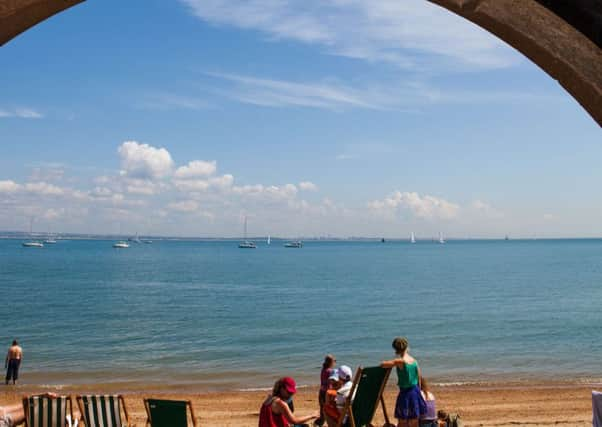Travel review: Queen Victoria's Isle of Wight retreat


If you think today’s media are intrusive, read this eyewitness account of what happened when Queen Victoria died: “The scene on the hill down to Cowes was disgraceful. Reporters in carriages and on bicycles were seen racing for the post office in East Cowes, and men were shouting as they ran ‘The Queen is dead!’”
It was January 1901 at Osborne House, the Isle of Wight home that 81-year-old Victoria loved. The bedroom where she died – “like a great three-decker ship sinking”, the Duke of Argyll recalled – is one of the more sober highlights of a visit to this consciously unstately home.
Advertisement
Hide AdAdvertisement
Hide AdOsborne was, Victoria said, a “little paradise for us... a place of one’s own, quiet and retired”. She and Prince Albert built it in the 1840s as a holiday retreat from court life and the crowds – a place where she could paint watercolours, picnic with her children and bathe in the sea from her private beach, all away from prying eyes.
Osborne came too late in her life to feature in Victoria, the ITV costume drama filmed largely in Yorkshire. The series takes her story only as far as her marriage, but English Heritage, which now runs the house and has restored it immaculately, is biding its time.
“We’re hopeful that they might come back and film here if they get recommissioned for a second or third series,” says Osborne’s marketing manager, Bryn Jones. It could, he reckons, trigger “the Downton effect” – in the way Highclere Castle, in neighbouring Hampshire, was rocketed from relative obscurity to star status after Downton Abbey was filmed there.
Stand by, then, for more coach parties, which is how my wife and I have come here. We’ve been touring far and wide over the Isle of Wight, which isn’t actually very far or very wide, and are watching Osborne’s Italianate towers emerge through the trees.
Advertisement
Hide AdAdvertisement
Hide AdThey were designed, in a style that might be called Teutonic Tuscan, by Prince Albert. Masterminding much of the rest of Osborne, including the sewage system, he was as creative as he was procreative: he fathered nine children in 17 years and then died, aged just 42, and plunged Victoria into half a century of mourning.
“Lots of people think of her as a dour lady in black clothes,” says Jones. “But this was a lovely family home full of fun and laughter.”
It’s certainly lighter and brighter than most Victorian country houses, perhaps reflecting Victoria’s love of fresh air. She was apparently impervious to cold. “All the windows were open and all the noses were blue at and after dinner last night,” Lord Clarendon complained in 1860.
Despite being surrounded by grand gardens and parkland, it feels like a family home, haunted by memories of one very important family’s private life and full of marble carvings of the children’s hands and feet and statues of favourite dogs.
Advertisement
Hide AdAdvertisement
Hide AdEven so, things were done on a grand scale. “Queen Victoria didn’t like the smell of cooking and Prince Albert was paranoid about fires,” says guide Martin Payne. The solution? Site the kitchens 100 yards from the dining room, load the meals on trolleys and push them through underground tunnels.
We see Victoria’s loo (disguised as a bench), a room with furniture made of stags’ antlers and another crammed with photographs of the couple’s pan-European and Russian descendants. “It was their stated aim to create a dynasty throughout Europe to keep the peace,” says Payne.
The plan failed spectacularly, but the grand titles echo down the decades: Prince Adolphus of Schaumburg-Lippe; Prince Ernest of Hohenlohe-Langenburg; Charlotte, Princess of Saxe-Meiningen-Hildburghausen. No wonder, when Victoria was looking for a “Highland servant”, she chose a man called John Brown.
After Albert’s death in 1861, the house became a shrine to the couple’s marriage. “Victoria said ‘Change nothing’,” says Payne. “For 40 years after his death, a bowl of hot water was still brought to his room every morning and his clothes were laid out.”
Advertisement
Hide AdAdvertisement
Hide AdThe climax of the tour is the Durbar Room, added to the main building ten years before Victoria died as a tribute to her role as Empress of India. Designed by John Lockwood Kipling, Rudyard’s father, it has a resplendent carved peacock, statues of Hindu gods, and cabinets of gifts – from the Talukdars of Oudh, “the ladies of Surat” and “Your Majesty’s loyal and devoted subjects of the Gonda District”.
And there’s a portrait of Abdul Karim, a young Muslim who became Victoria’s secretary. Their relationship was the subject of much speculation and is the inspiration for a new film starring Dame Judi Dench as the Queen. As you read this, it’s probably being filmed at Osborne. Watch out for the Downton effect.
GETTING THERE
Stephen McClarence was a guest of Visit Isle of Wight (visitisleofwight.co.uk) and the Coach Tourism Association. For Isle of Wight tours, visit findacoachholiday.com.
Yorkshire tour operators visiting Osborne House include Deidre Brown Travel (deidrebrowntravel.com) and Bibbys of Ingleton (bibbys.co.uk).
Osborne House: 01983 200022; english-heritage.org.uk/osborne.